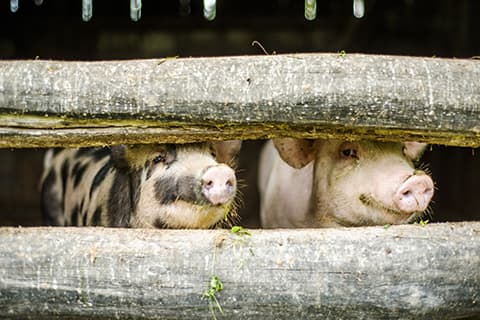In this week’s episode of The Round Barn, Dr. Jim Lowe and Dr. Ashley Mitek discuss African swine Fever (ASF) – how it evolved, what it means for the swine industry, where it’s spreading, and how that spread can and can’t be affected by human intervention. ASF is an extremely contagious viral disease. You won’t “catch” it – it’s only known to infect pigs – but it has devastating economic implications for any country it spreads to.
The virus originated in Sub Saharan Africa, where its environment shaped it into a highly contagious and resilient threat. Swine production in these areas is largely done in smallholder farms with a few or even just one pig, limiting the opportunity for spread and forcing the virus to spread in more creative ways. Most viruses die after their host dies; ASF thrives. So, ASF-contaminated carcasses and feces spread the disease across great distances.
The virus has been a serious detriment to African swine systems. Lately, it’s also been wreaking havoc in Eastern Europe. Because the virus evolved to spread across expanses of time and space, it’s been able to rapidly devastate more intensive swine systems in Eastern Europe. In many parts of Eastern Europe, villages raise a population of pigs to be butchered for the holidays. Meat products from the butchering are then shared to neighboring villages. While it’s technically possible to kill ASF by cooking, the virus would need to be heated to almost twice the boiling point of water. So, if any of the pigs in Village A were sick with ASF, then those holiday meat gifts given to Village B likely contain ASF just waiting for any chance to spread to more pigs.
This has been devastating for local swine industries. Under OIE guidelines, once a country has confirmed ASF cases, they can no longer export pork until they’ve eradicated the disease – which we currently have no way of doing. Once a country has ASF in any swine population, it’s extremely hard to prevent it from spreading to intensive farms, which leads to massive depopulations.
Romania would have been self-sustaining on pork, but they have to import a lot of pork now, because they’ve continued to depopulate their commercial farms in the face of ASF outbreaks.
Dr. Jim Lowe
Unfortunately, stopping the spread isn’t as easy as telling people to just not share their holiday meat gifts until ASF clears over. If we’ve learned anything from the last few years, it’s that sociology is just as important as epidemiology when it comes to policy. Dr. Mitek and Dr. Lowe dig into some of the intricacies of top-down decision-making, and why epidemiology needs to take culture and compliance into consideration.
As a young clinician, I was all about the science, and the black-and-white, and the facts, and what’s the disease, and what’s the treatment? And now, I realize, I think most veterinarians realize, there’s an art to it, and there’s a sociology aspect to it. We really can’t accomplish our mission without at least acknowledging it exists.
Dr. Ashley Mitek
ASF hasn’t yet landed in the United States, and many organizations and researchers are doing everything they can to make sure that remains true. Most recently, the disease was spotted in the Dominican Republic, which is the closest it’s been to the United States. This has resulted in tightened border security regarding meat and dogs, which are known to shed the disease.
If ASF were to be confirmed in the U.S., it wouldn’t necessarily be an immediate shutdown of all pork exports (the U.S. exports about 20% of its pork). Professionals and researchers are working on a regional quarantine plan that would allow the contaminated region to be rapidly cut off without affecting the rest of the continental U.S. Still, ASF would be devastating to the U.S., given the highly intensive nature of American swine production. Current biosecurity measures just aren’t enough to prevent the spread – beyond just contaminated meat and non-pig animals shedding the virus, we’ve also seen spread by mosquitoes and ticks.
To listen to the full conversation, click here.
